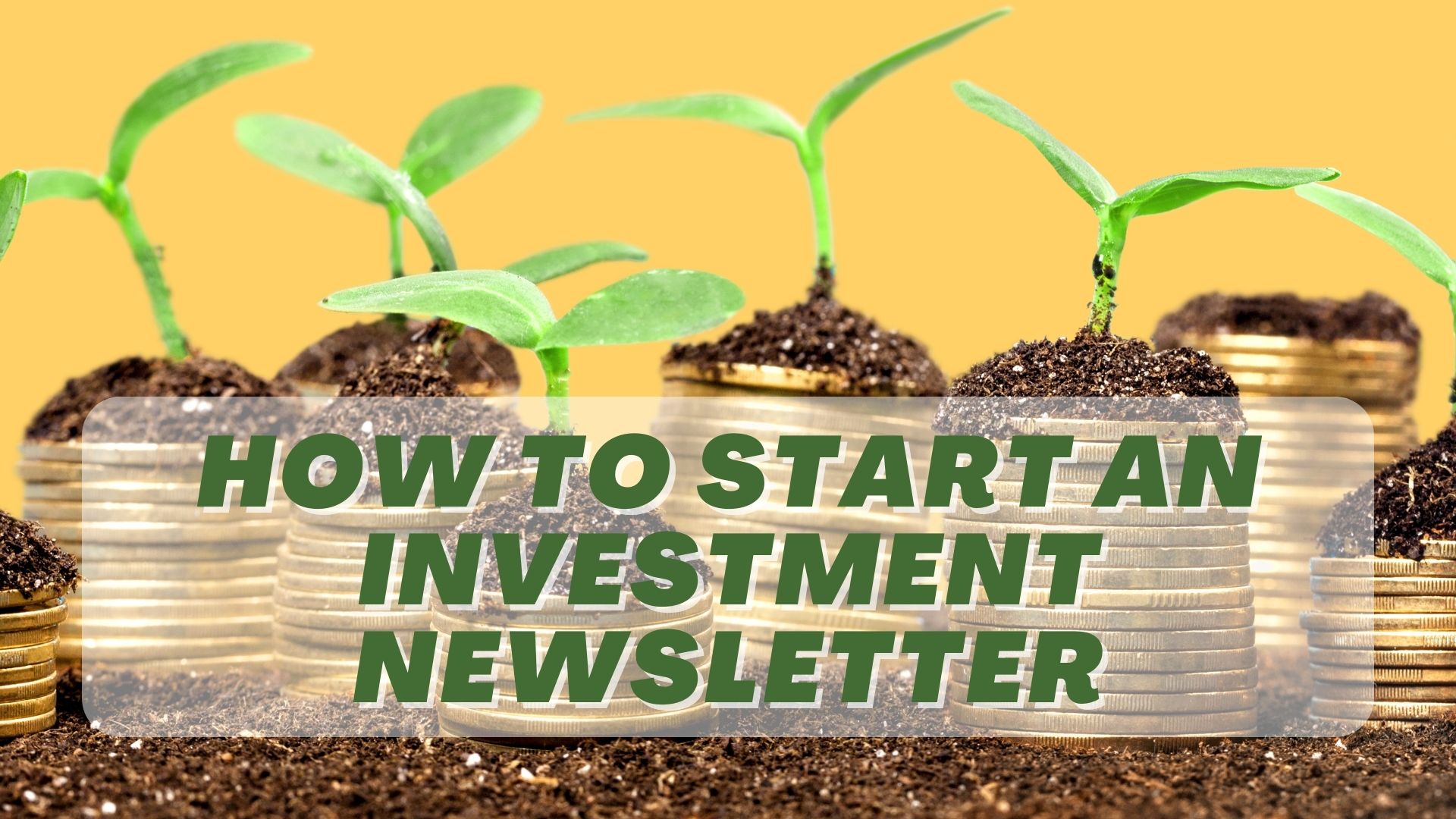Learn How To start an investment newsletter, begin with a clear summary of your newsletter’s purpose and focus. Then, consider financials and key performance indicators to share with your subscribers.
Include updates on your products and team, and end with a strong call to action.
Step 1: Identify Your Target Audience And Purpose
Starting an investment newsletter can be a rewarding endeavor, but it requires careful planning and execution. Step 1: Identify Your Target Audience and Purpose. Before you start writing your newsletter, it’s crucial to determine its purpose. Define what you want to achieve with your newsletter – is it to educate, provide market insights, or offer investment recommendations? Once you have a clear purpose in mind, you can move on to defining your target audience. Understand who your ideal readers are, their investment goals, and their level of expertise. This will help you tailor your content to meet their needs and interests.
Step 2: Choose A Format For Your Newsletter
To start an investment newsletter, one important step is to choose a format that aligns with your target audience and purpose. There are various newsletter formats to consider. You can opt for a traditional email newsletter, where you share valuable insights, stock trends, and guidance through simple emails. Another format could be a monthly PDF newsletter, which allows you to create a visually appealing and printable document that can be easily distributed. Additionally, you can explore video newsletters, where you record and share valuable information in video format. Choose a format that suits your target audience’s preferences and make sure it effectively communicates the content you want to share. By selecting the right format, you can engage your subscribers and provide them with valuable information in a way that resonates with them.
Step 3: Set Up A Newsletter Software
To set up your investment newsletter, it is important to research and choose a reliable newsletter software. This software will be the foundation of your newsletter and will help you manage subscribers, create and send emails, and track the performance of your newsletter. Look for a software that offers features like customizable templates, automated workflows, and analytics.
Once you have chosen a newsletter software, set it up by inputting your branding elements, such as your logo and color scheme. Create a subscription form to collect email addresses from interested subscribers. Set up email templates that align with your branding and create a schedule for sending out your newsletters. Take advantage of the analytics provided by the software to track the open rates, click rates, and other key metrics of your newsletters. This data will help you optimize your content and improve the effectiveness of your newsletter.
Step 4: Develop Compelling Content
When it comes to developing compelling content for your investment newsletter, it is crucial to research and stay updated on the latest investment trends. By staying informed, you can provide your readers with engaging and informative content that adds value to their investment journey.
Start by conducting thorough research on various investment topics and strategies. Stay updated on market trends, economic indicators, and industry news to provide accurate and timely information to your readers. Utilize reliable sources such as financial publications, industry reports, and reputable websites.
Additionally, consider incorporating real-life examples, case studies, and expert opinions to make your content more relatable and trustworthy. Use data and statistics to back up your claims and provide evidence-based insights.
In conclusion, creating compelling content for your investment newsletter requires continuous research and staying up-to-date on investment trends. By providing engaging and informative content, you can establish yourself as a credible source of information and attract a loyal subscriber base.
Step 5: Design An Eye-Catching Newsletter Template
When designing an eye-catching newsletter template for your investment newsletter, it’s important to choose a visually appealing template that grabs your readers’ attention. Look for templates that have clean and professional designs, with a good balance of text and visuals. Consider using colors that align with your branding to create a consistent look and feel.
Once you’ve selected a template, customize it to match your brand. Add your logo, choose fonts that are easy to read, and use images and graphics that enhance your content. Make sure the template is easy to navigate and visually appealing on both desktop and mobile devices.
Remember, your investment newsletter template is your brand’s first impression on your readers. By choosing a visually appealing template and customizing it to match your brand, you’ll create a professional and engaging experience for your subscribers.
Step 6: Promote Your Newsletter
When it comes to promoting your investment newsletter, leveraging social media platforms can be an effective strategy. Social media platforms like Facebook, Twitter, and LinkedIn have millions of active users, making them a great place to reach your target audience.
One way to promote your newsletter through social media is by collaborating with industry influencers or experts. These influencers have a large following and are trusted by their audience, which can help boost the visibility and credibility of your newsletter. You can reach out to them and ask if they are interested in sharing your newsletter with their followers or if they would be willing to contribute a guest article.
Another strategy is to create engaging and shareable content on your social media platforms. This can include infographics, videos, or blog posts that provide value to your audience and encourage them to share it with their own networks. You can also use social media advertising to target specific demographics or interests that align with your target audience.
Remember to include links to your newsletter subscription page or website in your social media profiles and posts, making it easy for interested individuals to sign up. Regularly posting updates about your newsletter, sharing testimonials or success stories from subscribers, and engaging with your audience through comments and messages can also help promote your newsletter and build a loyal following.
Step 7: Track And Analyze Newsletter Performance
Starting an investment newsletter can be an exciting journey, and tracking and analyzing its performance is a crucial step in ensuring its success. Utilizing analytics tools to track subscriber engagement is essential to understanding how your newsletter is performing. These tools can provide valuable data on metrics such as open rates, click-through rates, and subscriber behavior. By analyzing this data, you can gain insights into what content resonates with your audience and make informed decisions to improve your newsletter.
Regularly monitoring the performance of your investment newsletter allows you to identify trends, optimize your content strategy, and make adjustments to better meet the needs of your subscribers. It enables you to see what is working well and what areas can be improved, ultimately helping you to deliver a more valuable and engaging newsletter experience.
Step 8: Monetize Your Investment Newsletter
Once you have established your investment newsletter, it’s time to explore monetization strategies. One option is to include sponsored content in your newsletter. By partnering with relevant companies, you can feature their products or services and earn a fee for promoting them to your audience. Another strategy is to offer premium subscriptions. This allows you to provide exclusive content or additional perks to subscribers who are willing to pay a higher price. When developing a pricing model, consider the demographics of your target audience and your overall goals. You may choose a tiered pricing structure with different levels of access, or a flat monthly or annual subscription fee. Ultimately, the pricing should align with the value you provide and the expectations of your subscribers.
Step 9: Cultivate A Strong Relationship With Subscribers
Regularly communicating with your subscribers is crucial to cultivating a strong relationship. Engaging with your audience through feedback and discussions helps you understand their needs and interests. This allows you to tailor your newsletter content to provide value and keep them engaged.
When communicating with your subscribers, make sure to use a conversational and friendly tone. Encourage them to provide feedback, ask questions, and participate in discussions. Respond to their comments and inquiries promptly, showing that you value their input.
Consider implementing different communication channels such as email, social media, or a dedicated community forum. This allows for varied and accessible interactions with your subscribers.
By regularly communicating and engaging with your subscribers, you build trust and loyalty, increasing the chances of them staying subscribed and recommending your newsletter to others.
Step 10: Stay Compliant With Legal And Ethical Guidelines
When starting an investment newsletter, it is crucial to stay compliant with legal and ethical guidelines. Familiarize yourself with securities laws and regulations to ensure transparency and disclosure in your newsletter.
Complying with these guidelines will help establish trust with your audience and keep you out of legal trouble. Disclose any conflicts of interest and be honest in your investment recommendations. Clearly state that the newsletter is for informational purposes only and not personalized investment advice.
Remember to keep your newsletter concise and easy to understand. Avoid using jargon or complex language that may confuse your readers. Regularly review and update your compliance procedures to stay up to date with any changes in regulations.
By following these guidelines, you can build a reputable investment newsletter that provides valuable insights and guidance to your subscribers.
Step 11: Continuous Improvement And Adaptation
Continuous improvement and adaptation are crucial for the success of your investment newsletter. To stay updated on industry changes, it is important to constantly seek feedback from your readers and subscribers. Feedback can help you identify areas for improvement and make necessary adjustments to your content and strategies. Consider conducting surveys or engaging in direct communication with your audience to gather feedback. Implementing improvements based on feedback can enhance the quality and relevance of your newsletter, making it more appealing to your target audience. Additionally, staying updated on industry trends, news, and developments can help you adapt your strategies accordingly. This can involve keeping an eye on market movements, following financial news, and analyzing investment opportunities. By continuously improving and adapting, you can ensure that your investment newsletter remains valuable, informative, and attractive to your readers.
Frequently Asked Questions Of How To Start An Investment Newsletter
How Do I Start An Investor Newsletter?
To start an investor newsletter, follow these steps: 1. Begin with a summary, just like any important business document. 2. Decide on which financials and key performance indicators (KPIs) to share. 3. Include updates about your products and team. 4.
End with a clear call to action for your readers.
Are Investment Newsletters Legal?
Yes, investment newsletters are legal. However, federal securities laws require newsletters to disclose any payments received for promoting certain stocks. Some newsletters may fail to disclose this information, so it’s important to be cautious and do thorough research before relying on the information provided in a newsletter.
What Is An Investment Newsletter?
An investment newsletter is a simple email that provides valuable insight, guidance, and trends to help retail investors make better decisions and save time.
Are Investment Newsletters Worth It?
Investment newsletters may be cheaper, but they lack personalized advice and knowledge about your specific situation.
Conclusion
Starting an investment newsletter can be a lucrative and rewarding venture. By following the right strategies and putting in consistent effort, you can build a strong subscriber base and establish yourself as a trusted source of financial insights. One key aspect to consider is delivering valuable content to your audience.
Focus on providing unique and informative articles that offer insights into market trends, investment strategies, and expert analysis. This will not only attract new subscribers but also keep existing ones engaged and loyal. Another important factor is to establish a consistent publishing schedule.
By regularly sending out newsletters, you will develop a sense of reliability and professionalism among your subscribers. Additionally, make sure to use email marketing tools to create visually appealing newsletters and track their performance through analytics. To attract more subscribers, leverage social media platforms and promote your newsletter through targeted advertising and engaging content.
Building a strong online presence will help expand your reach and increase your chances of success. Remember, starting an investment newsletter requires dedication, creativity, and a deep understanding of your target audience. By following these guidelines and continuously refining your approach, you can create a successful investment newsletter that provides value to your subscribers and helps them make informed financial decisions.

Monica M. Watkins stands as a prominent authority in the realm of investment, recognized for her expertise as a “how-to” invest expert. With a robust background in finance and a keen understanding of market dynamics, Monica M. Watkins has become a trusted source for practical insights on investment strategies. Her career is characterized by a commitment to demystifying the complexities of financial markets and offering actionable guidance to both novice and seasoned investors. Whether unraveling the intricacies of stock market trends, providing tips on portfolio diversification, or offering guidance on risk management, Monica M. Watkins’s expertise spans a wide spectrum of investment-related topics. As a “how-to” invest expert, she empowers individuals with the knowledge and tools needed to navigate the ever-changing landscape of investments, translating complex financial concepts into accessible and actionable advice. Monica M. Watkins continues to be a guiding force for those seeking to make informed and strategic investment decisions, contributing significantly to the broader discourse on wealth-building and financial success.


